What happens when you add pineapple to jelly / Jello? Fun edible science experiment for kids!
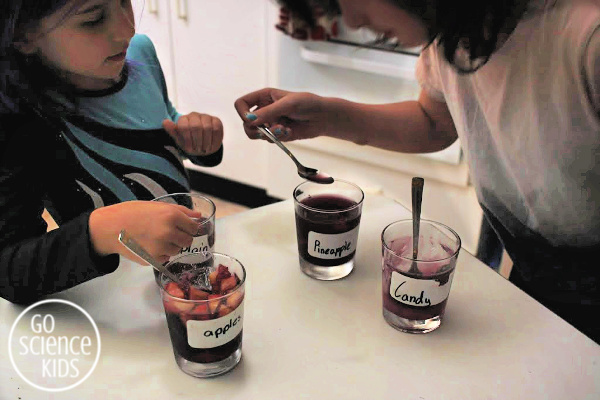
Have you noticed on your packet of jelly (or Jell-O as my North American friends call it), that there’s usually a small note that says “Do not add fresh pineapple, kiwi fruit or paw paw as jelly will not set.” Well, we noticed, and of course, we became intrigued!
But turning our curiosity into a pineapple & jelly science experiment was actually my 10 year old daughter Jewel’s idea. I suspect she:
a) wanted to make jelly
b) was intrigued by the warning label on the box, and
c) thought that suggesting a science experiment would be a good persuasive argument for why she should be allowed to make (and eat) a sweet treat! (She’s been learning about persuasive arguments at school…)
Well, she does know how best to convince me. 🙂
Suitable for
Playing with food is fun for all ages, especially if it ends in deliciousness! With slight modifications, this activity could work for anything from preschoolers or tweens!
These instructions below are for older kids, but if you did want to try this with little ones, you could modify by using ‘hot to touch’ (rather than boiling) water and cutting fruit and candy for them.

But first, let me clarify something that can be a little confusing. What we call jelly in Australia, is the same thing that North Americans call jello (or Jell-O). So, when I say jelly, I’m referring to jelly as a jiggly dessert, and not jelly as a spreadable fruit preserve (which. incidentally, Australians call jam). OK? Sorry about that, it’s an Australian / American / British English language thing…
Anyhoo, onto the experiment!
How to experiment with jelly and fruit (and candy)
We used:
- a box of flavoured jelly / jello crystals
- measuring jug
- boiling water & spoons to stir
- four equal sized glasses
- sticky labels and marker
- pineapple
- apple
- chewy fruit-flavoured lollies / candy

What to do
Because I was doing this with my 10 year old, we focused on conducting a “fair test” and following the Scientific Method. (This is a great thing to do with kids of all ages, but it’s especially good for older kids who can start to learn to think in a more structured, scientific way).
Step 1: Ask a question
What will happen if we add fresh pineapple to jelly?
Step 2: Form a hypothesis
Adding fresh pineapple to jelly will affect how it sets.
Step 3: Experiment
Jewel wanted to find out what would happen if you added pineapple to jelly, vs what happens if you add nothing (our control). She also wanted to see what would happen if you added another type of fruit (in our case, apple), to see if it was just pineapple, or any fruit, that affects the results. And she also wanted to see what happens if you add candy to jelly – mainly because she wanted an excuse to eat lollies. (Hey, she is 10!)
She chose four identical glasses and labelled them Plain, Pineapple, Apple and Candy. Then she made jelly according to the packet instructions, and poured an equal amount into each glass. I cut the apple, pineapple and lollies into small cubes (taking care not to cross-contaminate) and Jewel added these ingredients to their respective glasses.
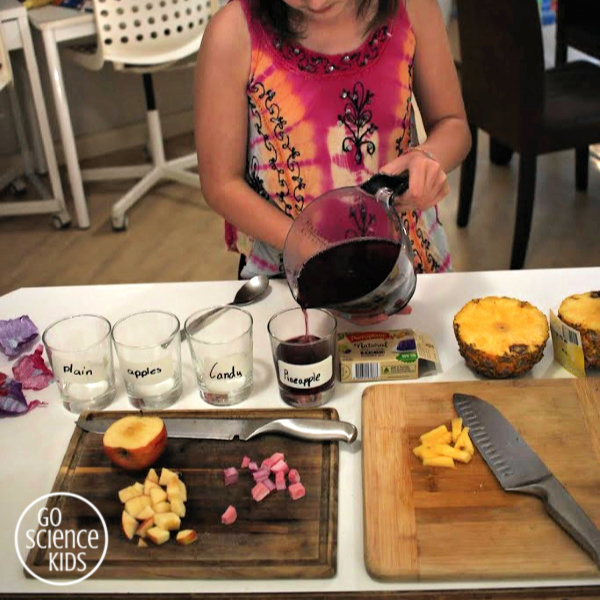
Then all four glasses were placed in the fridge for the same amount of time to set.
Jewel tried to keep as much of the experiment consistent as possible (eg, the size of the glass, the amount of jelly mix that was added to each glass, the temperature of the fridge, the amount of time that the jelly was left to set), so that we could see the effect of the one independent variable that was changed (the pineapple, apple and candy), vs the control (the plain).

Step 4: Observe and record
After four hours (the amount of time that the jelly packet recommended), we removed the four glasses from the fridge to observe (and taste) the results. Jewel’s little sister Bumble Bee (who is 7.5 years old) miraculously appeared for this part!
The girls noticed that:
a) all four glasses were cold
b) the plain jelly looked and tasted as expected – it looked solid, but jiggly, and tasted sweet.
c) the pineapple jelly didn’t set at all! It was cold, but still very much a liquid. The taste was similar to the plain jelly. The pineapple pieces had sunk to the bottom of the glass and looked sodden and jelly-stained.
d) the apple jelly had apple pieces suspended towards the top of the glass. The apple pieces weren’t very discoloured. The taste of the jelly was similar to the plain jelly, and the apple pieces added a nice texture.
e) the candy jelly didn’t have any candy pieces in it any more – they had dissolved! The jelly towards the bottom part of the jar was pinker, sweeter and slightly slimier than the jelly towards the top part of the jar, suggesting that the candy didn’t dissolve evenly throughout the mixture.
f) the girls liked the taste of the candy jelly best, then the plain jelly, then the apple jelly, and the pineapple jelly least.

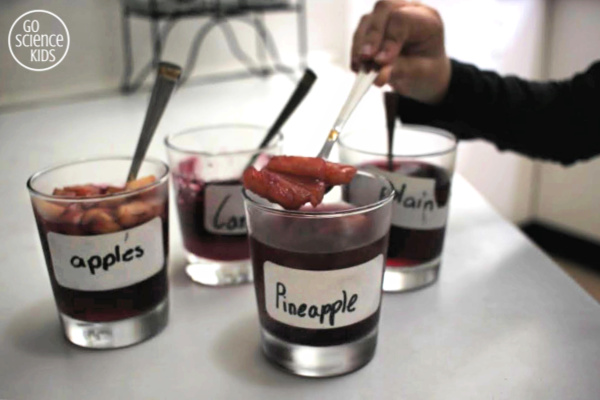
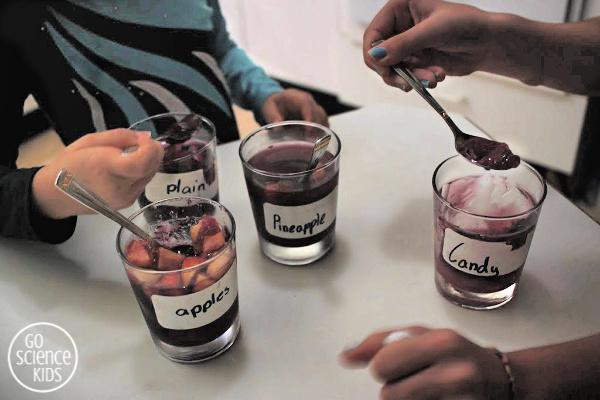
Step 5: Draw conclusions based on your observations.
The girls concluded that adding fresh pineapple did indeed affect how jelly sets.
They had some follow up questions, which may lead to more jelly experimentation in the future!
a) does the amount of pineapple affect the results
b) do fresh and tinned pineapple yield similar results
c) what other fruits might have a similar affect
Step 6: Share your findings
Hence this blog post! This is what we found. (If you did this experiment too, please add your findings in the comments below.)
Fun facts
Why does fresh pineapple stop jelly from setting?
Well firstly, let’s look at why jelly sets in the first place. Jelly contains gelatine (or gelatin), which is made up of a protein that dissolves in hot water. As the water cools, the protein molecules come out of the solution and turn back in to a solid, but instead of settling at the bottom of the bowl, they stick together in a complex matrix, catching the water molecules within, and create a sort of solid-liquid limbo.
Pineapple, however, contains a chemical called bromelain, which has protease enzymes in it that break down protein. This stops the jelly from being able to create its matrix structure as it cools, and so it doesn’t set and remains a liquid.
However, if you heat the enzymes sufficiently (eg as what happens to pineapple in the canning process), then the enzymes are generally inactivated. This is why you can add canned pineapple to jelly and it will still usually set.
Papaya, mango, guava, pawpaw and kiwi fruit also contain protease enzymes, so adding any of these fresh fruits will also stop your jelly setting.
You can find more interesting info on this here.
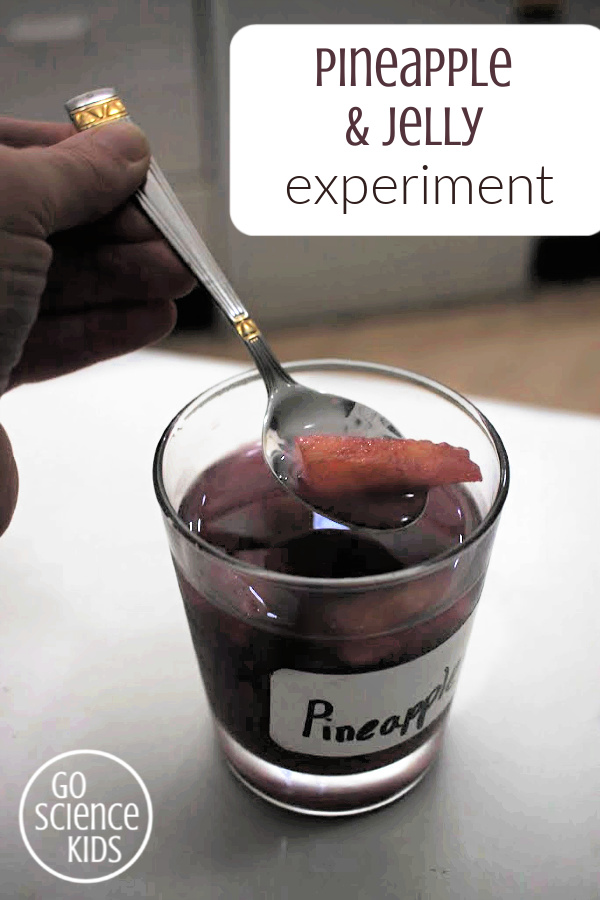
Please note…
All kids’ activities on this blog require attentive adult supervision. Parents and carers will need to judge whether a particular activity is appropriate their child’s age and skill level. Click here for more information.
Please be especially careful with boiling water and sharp knives. If your child is not ready to handle boiling water, please consider substituting ‘hot to touch’ water instead. Likewise, if your child is not ready to handle sharp knives, please consider cutting the fruit and candy for them.
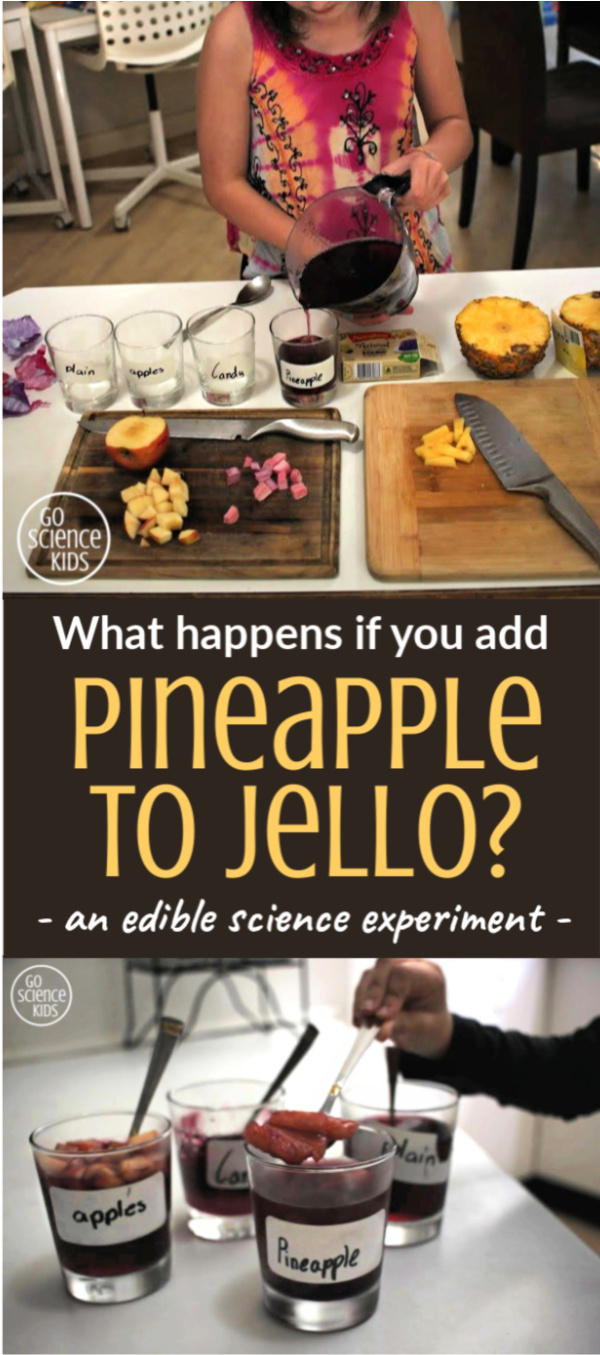
- Is jelly a solid or a liquid? A fun exploration into the states of matter that young kids will love…
- How to make fizzy sherbet and experience a chemical reaction right on your tongue!
- how to make homemade violet crumble. Warning: this is really delicious.
You might also like to follow our Go Science Kids and Edible Science for Kids boards on Pinterest.
And, of course, you can always subscribe, to receive all our latest activities straight in your Inbox.


#
Ok this is sooo sooo cool! Thank you for sharing this! I cannot wait to do this with my 11 year old. So I haven an excuse to make Jello lol